iMovR SteadyType Exo Ergodynamic Keyboard Tray Review
- Lab tested
Like most reviews sites, our editorial staff and laboratory testing expenses are partially offset by earning small commissions (at no cost to you) when you purchase something through those links. Learn More

Overview
| Review Summary |
The SteadyType Exo is an overachiever. Its raft of awarded patent claims is just the start. Among ergonomic keyboard trays, it is not only the most stable and durable design we’ve ever tested, the easiest to install, and the best at achieving steep “negative” ergonomic tilt angles; it is all of those things by a large margin. While the SteadyType Exo does not offer the ability to retract your keyboard underneath the desktop, its ability to install in just 30 seconds to literally any standing desk with a straight front edge, and to accommodate virtually any combination of keyboard and pointing device imaginable, forges a new and exciting category of adjustable keyboard trays. We can state categorically that it is the most ergonomically versatile add-on keyboard tray for standing desk and treadmill desk users on the market today. |
|---|---|
| Best Use |
Any standing or treadmill desk user looking for impeccable stability, ease of installation, and much steeper tilt angles than typically available in adjustable keyboard trays. |
| MSRP / List Price | $360 |
| Street Price |
iMovR currently has an exclusive offer for WorkWhileWalking readers going on! Get 15% off everything in your cart with the coupon code WWW15. |
| Warranty |
Lifetime on metal frame, 5 years on 3D-laminated tray |
| Colors Available |
Available in all 24 3D-laminate colors that iMovR offers on their standing desks. |
| Construction |
Precision-welded American steel frame, and advanced, ultra-durable 3D lamination on the ergo-contoured keyboard tray. |
| Adjustment Range |
Tray rotation: 360° |
| Dimensions |
Keyboard tray: 28″ x 10.5″ |
| Product Weight |
15.5 lbs |
| Shipping Weight |
22 lbs. |
| Typical Assembly Time |
30 seconds |
| Competition |
Top-Rated Ergonomic Keyboard Tray Reviews
|
| Where to buy |
Buy on iMovR |
Rating
| Ease of Assembly | |
|---|---|
| Stability | |
| Safety | |
| Reliability | |
| Customer Experience | |
| Quality and Aesthetics | |
| Ergonomics | |
| Innovation | |
| Value | |
| Positives | A testament to American R&D and manufacturing quality, the SteadyType Exo is incredibly stable—the most stable ergonomic keyboard tray we’ve tested by an order of magnitude. Installation is astonishingly quick and easy. We’re talking 30 seconds versus the usual hour+ ordeal of installing a keyboard tray. Not limited to the usual +10°/-15° of tilt, this tray can literally rotate 360° (but practically speaking can hold the keyboard and mouse in place up to a near-vertical -85° of tilt). The luxuriously 3D-laminated keyboard platform can accommodate any keyboard and any keyboard/pointing device setup imaginable. Clever “bumpers and pins” allow you to position the keyboard and pointing device as close to your body as possible, to prevent forward shoulder rolling and keep your posture upright. |
| Negatives | There is no way to retract the keyboard under the desk with this kind of tray, it is fixed in place (though technically can be removed in seconds, or even ported between different desks). The attachment clamp requires a straight front edge so it will not work for standing desks like the UpLift Eco Curve that have a concave contoured user edge or at the “inside elbow” of an L-desk. The price is high compared to far inferior commodity keyboard trays made in China, albeit those do not have the ability to achieve truly neutral typing angles needed for standing desk or treadmill desk use. |
Bottom Line
What’s the Actual Point of Having a Keyboard Tray?
An ergonomic keyboard tray (a.k.a. “articulating keyboard tray,” “adjustable keyboard tray” or abbreviated simply as an “AKT”) is any keyboard tray that corrects two problems caused by placing your keyboard directly on your desk.
The first problem it solves is height—without a keyboard tray, most desktops are too high for strain-free typing, causing you to engage muscles that should be more relaxed. Just about any under-desk keyboard tray will alleviate this issue.

The second problem an ergonomic keyboard tray addresses is tilt. For your wrists to be properly aligned, your keyboard should be able to achieve a “negative tilt” of -10° to -15° when seated at a fixed-height desk. The only reason for not going any steeper at a fixed-height desk is that your lap would be in the in the way.
The AKTs of yore were designed to overcome the innate inadequacy of sitting desks, allowing you to type in a way that’s a little more neutral for your wrists, elbows, and upper body. This decreases the likelihood of developing RSIs (repetitive strain injuries) such as carpal tunnel syndrome. RSIs resulting from a poor keyboard setup most commonly strike in the wrists, forearms, hands, fingers, elbows and shoulders.
RSIs can manifest in numerous ways, but most commonly as stiffness or weakness, tingling, pins-and-needles, numbness, muscle cramps, swelling, or outright pain—which may feel like burning, aching or throbbing. The good news is these nasties can be avoided with the installation of a proper ergonomic keyboard tray. (It’s also important to address RSI’s from improper monitor setups; see our guide to the best ergonomic monitor arms for standing desks.)
It’s important to recognize that when you’re working at a standing desk or treadmill desk—without chair armrests to support the weight of your forearms—the concept of a “neutral” elbow angle changes from the inherently limited -90° to -105° to a much greater angle, up to -140° or even more. Working at a more obtuse angle aids in relieving multiple muscles and tendons from the strain of pulling against the force of gravity as you type.
Or, more practically speaking, “the steeper, the better” to avoid RSIs while maximizing your typing comfort and proficiency (i.e. your typing speed and rate of committing typos).
The ability to retract the keyboard under your desk is a common feature of AKTs, but technically not related in any way to ergonomics. A simple keyboard drawer will take care of that much less expensively. In fact, many people who inherited a keyboard tray at their work desk never even learned how to set its angle for proper ergonomics (many, in fact, use their keyboards at an ergonomically-egregious positive tilt inclination out of common ignorance), and only appreciate it for its retractability.
So for the rest of this review, we’re going to limit our discussion to a keyboard tray’s ergonomic functions, since retraction ability is the one thing you won’t get with the SteadyType Exo. That said, it takes only seconds to remove temporarily from any desk, so even if you do occasionally want to make the keyboard disappear, it is trivial to do so.
If retractability is an important feature for you, however, be sure to take a look at iMovR’s SteadyType Slide, which is the exact same keyboard tray but permanently mounted on slide rails instead of being portable like the Exo.
Enter SteadyType and ‘Ergodynamics’
iMovR already changed the ergonomics game in standing desk and treadmill desk ergonomics with their SteadyType technology, originally patented in 2014. iMovR’s groundbreaking research in this area helped spawn the ergonomic subspecialty of ‘ergodynamics‘, which encompasses the different body positions and motions of a computer user in motion, i.e. when standing or walking, not sitting in a chair. This includes research into keyboard trays, monitor arms, anti-fatigue mats, balance boards, and other ergonomically-focused design elements of standing desks and treadmill desks.

Specifically regarding keyboard placement, the basic concept is that while you’re in the upright position (either standing or walking), the most ergonomically neutral, non-straining position for your arms is akin to the posture of a sleeping astronaut—with elbows bent not at 90° like most standing desk advertisements show, but with your arms resting closer to your sides and your elbows at wider angles, typically 115° -140°.
SteadyType keyboard trays are the only ones on the market that accommodates what ergonomists who were actually trained on standing desk and treadmill desk ergonomics consider truly neutral arm angles. For more on adjustable keyboard tray options for treadmill desks, see our primer on the subject. After testing many of iMovR’s SteadyType-equipped desks in the past (including the Lander, Jaxson, and even their older models like the Cascade, Denali, Olympus, and Everest), there is a marked difference in terms of typing endurance especially; a SteadyType-equipped desk allows the user to type for hours at a time, while a normal flat-surfaced standing desk leads to faster fatigue.
Now with the SteadyType Exo (as well as iMovR’s retractable version of this, the SteadyType Slide), you can garner these benefits on virtually any existing standing desk.
Negative tilt is perhaps the single most important concept that many users, and even salespeople and websites that sell keyboard trays, get reversed in their minds. It’s easy to understand why this happens. The very word “negative” sounds counter-intuitive. But, in fact, it’s a negative tilt, as shown in the photo on the right, above, that you want to achieve with an ergonomic keyboard tray.
The only application for positive tilt is typically for gamers who want to lean way back in their chairs and still be able to see and reach their keyboards. And for those gamers the SteadyType Exo has infinite adjustability, not limited to just a 10° positive tilt range.
In general, keyboard trays allow you to tilt the edge of your keyboard that’s closest to the user upwards, bringing it into a negatively-inclined position from the perspective of where your wrists are resting on the user edge of the keyboard. While this may depart from old-school, pre-ergonomic keyboard design (pop-up tabs on many keyboards used to let you elevate the back—a humongous ergonomic no-no) it’s actually ergonomically proper to tilt the keyboard the other way.
It’s only by placing the keyboard at a negative tilt that wrist flexion—and consequent squeezing of the carpal bones that surround the nerves and blood vessels that pass through them—can be neutralized. We’ve never been able to figure out how the computer industry started down this path of tilting keyboards in exactly the opposite direction as is ergonomically correct; the myth has persisted for decades and millions of computer users are still unaware.

Because the SteadyType Exo rotates around a metal pipe, you can technically achieve a full 360° rotation. The tilt options are only limited by how well your keyboard and mouse can remain on the tray.
We were able to tilt the Exo down to a near-vertical 85° without losing the keyboard or mouse off the tray. Its innovative method of holding onto these peripherals at such steep angles is one of the patented aspects of the design.
The Usual Problems with Ergonomic Keyboard Trays
Knowing what ergonomic keyboard trays are supposed to accomplish, let’s see what often gets in the way. We looked at the negatives from all of our keyboard tray reviews over the years, and two issues consistently bugged us: Difficult installation and shakiness. Of course, there were many other frequent issues like no negative tilt (literally Chinese knockoffs that got the rotation direction reversed), difficult adjustment, lack of fencing to keep peripherals from sliding off the tray, etc., but it almost always came back down to that pair of fundamental issues.

Ergonomic keyboard trays are usually hard to install and they are usually very “floppy” due to the combination of loose joints in the mechanism, from the glide rail to the adjustable arm to the cheap, flexible plastics (typically phenolic) used to construct the tray itself.
The SteadyType family of keyboard tray options, including the Exo, the Slide, and the built-in version like on iMovR Lander desks are the exception to the rule.
Ergonomic Keyboard Trays are Usually Hard to Install
Anyone who has ever installed a keyboard tray knows what a project it can be. First, you have to flip your desk over, drill pilot holes using a paper template, screw in the slide rail, assemble the keyboard arm, slide it into the rail, and install the rail stop hardware. And that’s if you don’t have to redo the job because you eventually realize that the keyboard tray is centered on the monitor and not on your Numpad-equipped keyboard, leading you to have to undo it and reinstall the tray a few inches over to the right. Bottom line, it’s never a simple task. (We should point out the one exception to this is if you add a SteadyType Slide to an iMovR Lander or Jaxson desk, the desktops are pre-drilled for it.)
We’ve come across many products with hyperbolic claims about assembly time, but the SteadyType Exo truly nails its proclamation of 30 seconds (see the video for the full installation). It has a long edge clamp that is secured to the user edge of your desk with just two knobs. Two more knobs, set eight inches back from the user edge of the desk, allow you to perfectly level the SteadyType Exo in case the tabletop has a lip on it.

The SteadyType Exo is technically portable in the sense that you can uninstall it very quickly—it’s the opposite of the 30-second process to install. In over a decade of testing keyboard trays we’ve never seen another one that’s “portable” in this way.
Because of its size and weight (15.5 lbs), you wouldn’t want to carry it around often, though you could if you wanted to share it between two desks or multiple users.
Ergonomic Keyboard Trays are Usually Shaky
SteadyType-based keyboard trays are in an entirely different stability class compared to traditional keyboard trays. iMovR produced the video below to show just how solid SteadyType Exo is by dropping increasingly large and heavy fruit on the tray, compared to other popular tray models being put through the same torture test.
This is one of those instances where we couldn’t come up with 1,000 words to describe the Exo’s stability better than a picture could, so it’s probably better to just watch the video and see for yourself. This thing is a rock. Because of the strong connection between the tray and the desk, any shakiness we felt was inherent in the desk itself, not the tray.
Like any keyboard tray, adding a SteadyType Exo will create a longer “moment lever” on the desk. It sticks out from the desk about 12” and will exaggerate any instability that already exists in the desk. While it can’t solve the physics inherent in any 2-legged standing desks (see our primer on Why Some Desks Are Shakier Than Others) it at least won’t add to any instability of the desk at taller heights.
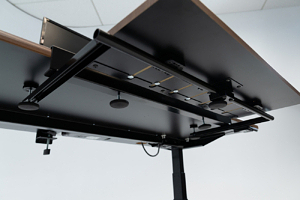 The undercarriage of the Exo evidences the precision machining and welding that makes it so robust and rock-solid.
The undercarriage of the Exo evidences the precision machining and welding that makes it so robust and rock-solid.Inspecting the SteadyType Exo up close, it’s clear the construction pays off. Other ergonomic keyboard trays often sneak things in like hollow plastic keyboard platforms or obviously floppy joints, all in the name of cost reduction. These shortcuts aren’t present in the SteadyType Exo. The construction looks and feels top-notch.
The Exo’s design also avoids the accumulation of tolerances of each joint that lead to shakiness with most ergonomic keyboard tray designs that feature the typical rail, swivel point, arm, keyboard platform, and sometimes mouse platform.
More Color Choices Than Any Other Keyboard Tray
Most keyboard trays come any color you’d like, as long as it’s black. A few, like the premium trays from Humanscale, come in black, white or silver. The SteadyType Exo (as well as the SteadyType Slide) is available in a whopping 24 color options.
The keyboard tray itself is gorgeous, finished in the same exclusive Surf(x) 3D laminate that iMovR has been using for many years to make their ultra-durable standing desk work surfaces. The surface is pleasant to the touch and extremely resistant to damage from scratches, dents or even cleaning chemicals while looking pretty.
The steel frame of the SteadyType Exo is powder coated in a durable, matte finish, with solid weld joints. All the components are made in the USA, just like iMovR’s standing desks. The four clamping knobs and the main adjustment knob for setting the tilt angle of the tray are easy on the hands, with rubber grips to make them extremely easy to turn.
Compatibility
We spend a lot of time talking about the available “draft” your desk needs to have underneath the desktop to accept a keyboard tray’s installation (we even wrote an entire primer on the subject of adding an adjustable keyboard tray to a standing desk).

Because most adjustable-height desks have a crossbar running between the tops of the lifting columns, there just isn’t enough space for the rail of many keyboard trays to fit (although there is now an adapter that allows you to get around this issue). That’s why most standing desks do not have an ergonomic keyboard tray installed.

In contrast, the SteadyType Exo requires only 8.25” of draft, so it will not interfere with the crossbar on any adjustable height desk. Its draft required is less than other ergonomic keyboard trays we’ve reviewed that were specifically designed for adjustable-height desks like the Humanscale Float (12”) or even the iMovR Trackless (9”).
This universal fit with crossbars is a big deal. It’s one less dimension to consider for fit, especially since that dimension isn’t always easy to find in advertised features (or even correct when you do find it, like in the case of the Seville Airlift 360).
There are some limited desk situations where the SteadyType Exo won’t fit well, like an UpLift desk with an Eco Curve. An L-desk with a curved work surface where the left and right sections of the desk meet will create a similar challenge to installation. For these, the SteadyType Slide or iMovR’s Trackless Keyboard Tray might be a better solution.
Bumpers and Pins
The SteadyType Exo comes with four rubber bumpers that can go into any of the seven slots on the tray. The primary purpose of these is to keep your keyboard from sliding off the tray when it is at steeper angles.

A secondary purpose is to allow you to keep the keyboard as close to the user edge as possible. This is an ergonomic feature we haven’t found on any other keyboard tray yet. The idea is to keep your shoulders as far back as possible, thus reducing our propensity to get into a “computer hunch” posture.
The bumpers can slide back and forth in any of the seven slots to fit the back-edge contour of the keyboard design. We tried every keyboard/pointing device setup we could imagine being used and they all worked perfectly with these bumpers. This includes split keyboard halves (each keyboard half can even be individually canted to eliminate the dreaded “ulnar deviation” that instigates carpal tunnel syndrome).
The platform is 28” wide, which will fit any keyboard on the market—even larger ones like the popular Microsoft Natural 4000—as well as any kind of pointing device, from a mouse to a trackball or even a large trackpad.
There are three “zones” where you can put the three pins that hold your pointing device in place. The zones are for right-handed and left-handed users, plus a center zone for anyone with serious ergonomic shoulder or elbow injuries who needs their pointing device planted between split keyboard halves.

We found this to work well once you get past the brief hesitation of trusting your mouse will slide to the nest of pins and not fall off the tray when you let it go. There is a small learning period where you have to get used to retrieving the mouse every time you want to use it since it’s in a different spot than where you left it. The movement feels completely natural after just a few minutes of use and overall the SteadyType Exo is very easy to use.
Whatever Happened to the Elevon?
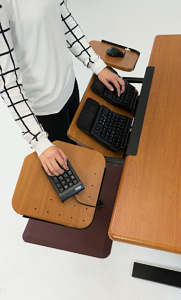 The original iMovR Elevon was a much larger version of the Exo, popular with ergonomics.
The original iMovR Elevon was a much larger version of the Exo, popular with ergonomics.If you’ve been reading our reviews for a few years you may recall that iMovR did have a somewhat similar looking predecessor to the Exo that it launched on Kickstarter in 2017, called the Elevon. We were just as excited about its introduction as we were for the SteadyType Exo four years later, but the Elevon was definitely aimed at a much more specialized market. It was most popular with professional ergonomists who had to contend with hard luck clients with significant ergonomic injuries.
The Elevon remains the most adjustable keyboard tray ever created, one which ergonomists would turn to it when no other keyboard tray would work for a client. Alas, it turned out to be too large, too heavy and too expensive for the mass market. iMovR has suspended production on it for the time being, in favor of developing the SteadyType Exo and SteadyType Slide, which are great options for the 99% of standing desk users who don’t have any serious movement limitations, and don’t need something as fancy as the Elevon.
How Does The Exo Compare To The Slide?
That’s an easy question to answer. The Exo is designed to attach to the front edge of any standing desk in 30 seconds, and is removable and therefore “portable.” It only needs 8 inches of clearance underneath the desktop to install.
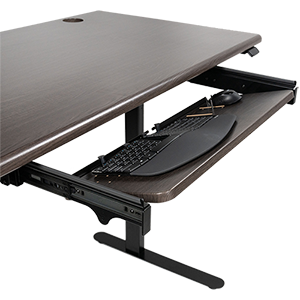 The retractable version of the SteadyType Exo is the new SteadyType Slide, which has an identical tray but permanently mounts on slide rails.
The retractable version of the SteadyType Exo is the new SteadyType Slide, which has an identical tray but permanently mounts on slide rails.The SteadyType Slide is a newer version of the Exo that is built with the exact same tray system, but permanently mounts on slide rails to any standing desk with sufficient clear space underneath the desktop. If you already own an iMovR Lander or Jaxson desk it is pre-drilled for the Slide, using the same holes as for the iMovR Premium Drawer. It’s an either/or situation, you can obviously have only one of these options installed on your desk, the keyboard tray or the drawer.
There is no comparing the SteadyType Slide to other retractable keyboard trays we’ve reviewed in terms of stability. The rails are solid, and there’s a locking knob to set your keyboard tray depth exactly where you want it (we haven’t seen this feature on any other keyboard tray ever). The Slide costs about $130 more than the Exo.
Quality Construction, Solid Warranty and 100% Factory Pre-Assembled
The Exo’s manufacturing quality is evident in every component, as we already described above. The warranty reflects this with its 15-year coverage, same as on iMovR’s 3D-laminated standing desks. Like all iMovR products the Exo also comes with a 100-day satisfaction guarantee.
The tray arrived in robust protective packaging, already fully assembled. Video installation instructions as well as a very well written installation manual make it easy to set up the Exo for any conceivable combination of keyboard and pointing device. There’s even a video on how to set up your Exo for maximum ergonomic benefits.
The Takeaway

As far as negative tilt capability, ease of installation, and stability, it’s not hyperbole to say the SteadyType keyboard tray technology has changed the game for standing desk and treadmill desk users. The Exo was clearly designed and made with one thing in mind: Improving your ergonomics while typing at an active workstation. And it will do just that. No caveats.
We didn’t find any notable negatives of the design other than its lack of retractability. However, this lacking feature is fairly well negated by the ease with which you can remove the tray. Again, installing and uninstalling really is as easy as it sounds.
That said, we absolutely love the new SteadyType Slide, which solves the one deficiency of the Exo for many users. It’s our top-rated keyboard tray for standing desk and treadmill desk applications, and works great when seated as well. Again, the only difference between the Slide and the Exo is that the Slide is permanently mounted on retractable slides.
The ability to easily achieve steeper, more neutral negative tilt positioning of the hands and forearms while remaining rock-solid stable, makes the SteadyType Exo far and away the top ergonomic keyboard tray for standing and treadmill desks. To learn about other SteadyType options specifically designed for walking desks check out our primers on How To Install a Keyboard Tray On A Standing Desk and How To Install A Keyboard Tray On A Treadmill Desk.
What to do when you want to take a conventional keyboard tray off your old fixed-height desk and transfer it to your new standing desk instead? A common issue that people have when installing keyboard trays on standing desks is being incompatible with the crossbar under adjustable-height desks. iMovR’s Keyboard Tray Standing Desk Adapter Kit offers an easy workaround to this problem without sacrificing any adjustability or stability
Articles About Keyboard Tray Ergonomics That Will Interest You
• How To Avoid Carpal Tunnel Syndrome, Neck Pain And Shoulder Spasms While Typing
• How To Set The Proper Keyboard Tray Height For Maximum Ergonomic Benefits
• Is A Sedentary Desk Job, The Most Dangerous Job In The World?
• What Employers Urgently Need To Know About Kitchen Table Ergonomics

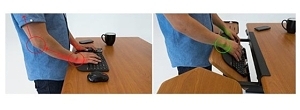
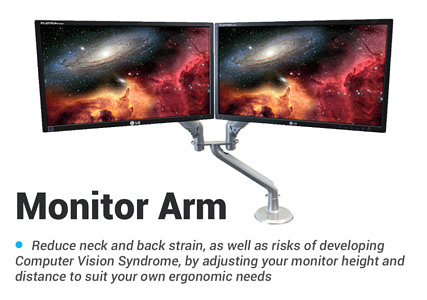
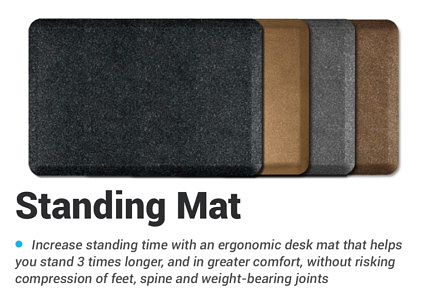
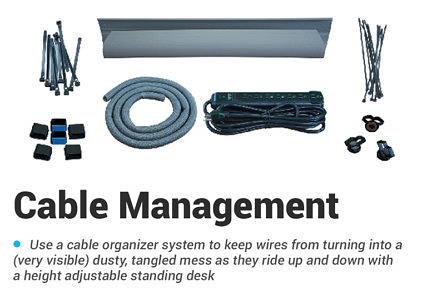
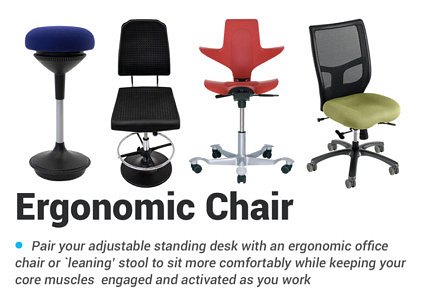
0 Comments
Leave a response >